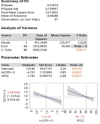Long Term Respiratory Follow-Up for COVID-19 Patients a Multicenter Study
- PMID: 35444815
- PMCID: PMC8987475
- DOI: 10.12865/CHSJ.47.04.05
Long Term Respiratory Follow-Up for COVID-19 Patients a Multicenter Study
Abstract
Background: The first wave of the COVID-19 pandemic initiated officially in October 2020. Since then several observations have been made regarding the disease and its symptoms.
Patients and methods: We included eighty seven in our observational study. Our main aim was to investigate their long term respiratory follow-up in correlation with their initial radiological and laboratory findings and values. The nose swab PCR test for COVID-19 was used for diagnosis. Patients were monitored at 3 and 6 months after their hospital reception whereas basic parameters of health condition (smoking, PO2, SPO2, WBC, CXR, CRP, intercurrent findings, days of nursing, colchicine administration) in joint with gender and age were recorded.
Results: Males seem more susceptible to the viral disease than females in a ratio 1,8:1. The parameters FEV1 and FVC (as % relative changes) were not affected, apart from the DLCO to which CRP (in loge+1 transformation) and SPO2 showed a statistically significant effect.
Conclusion: None of these patients were intubated, or admitted to the intensive care unit. The respiratory function is affected by the virus and the effect is reversed within the first three months. Males are more affected and the radiological and laboratory findings are associated with the respiratory functions.
Keywords: COVID-19; DLCO; FEV1; FVC; respiratory functions; respiratory infection.
Copyright © 2014, Medical University Publishing House Craiova.
Conflict of interest statement
None to declare.
Figures






Similar articles
-
Observational study of clinico-radiological follow-up of COVID-19 pneumonia: a district general hospital experience in the UK.BMC Infect Dis. 2021 Dec 8;21(1):1233. doi: 10.1186/s12879-021-06941-8. BMC Infect Dis. 2021. PMID: 34879817 Free PMC article.
-
Follow-Up Analysis of Pulmonary Function, Exercise Capacity, Radiological Changes, and Quality of Life Two Months after Recovery from SARS-CoV-2 Pneumonia.Medicina (Kaunas). 2021 Jun 3;57(6):568. doi: 10.3390/medicina57060568. Medicina (Kaunas). 2021. PMID: 34204878 Free PMC article.
-
The characterisation of pulmonary function in patients with mucopolysaccharidoses IVA: A longitudinal analysis.Mol Genet Metab Rep. 2019 Jul 12;20:100487. doi: 10.1016/j.ymgmr.2019.100487. eCollection 2019 Sep. Mol Genet Metab Rep. 2019. PMID: 31341787 Free PMC article.
-
Safety and Efficacy of Imatinib for Hospitalized Adults with COVID-19: A structured summary of a study protocol for a randomised controlled trial.Trials. 2020 Oct 28;21(1):897. doi: 10.1186/s13063-020-04819-9. Trials. 2020. PMID: 33115543 Free PMC article.
-
[Basic spirometry measurements in workers on pig farmers].Srp Arh Celok Lek. 2004 Mar-Apr;132(3-4):85-91. doi: 10.2298/sarh0404085d. Srp Arh Celok Lek. 2004. PMID: 15307309 Serbian.
References
-
- Radovanovic D, Pini S, Franceschi E, Pecis M, Airoldi A, Rizzi M, Santus P. Characteristics and outcomes in hospitalized COVID-19 patients during the first 28 days of the spring and autumn pandemic waves in Milan: An observational prospective study. Respir Med. 2021;178:106323–106323. - PMC - PubMed
-
- Venkatesan S, Myles PR, Bolton KJ, Muthuri SG, Al Khuwaitir T, Anovadiya AP, Azziz-Baumgartner E, Bajjou T, Bassetti M, Beovic B, Bertisch B, Bonmarin I, Booy R, Borja-Aburto VH, Burgmann H, Cao B, Carratala J, Chinbayar T, Cilloniz C, Denholm JT, Dominguez SR, Duarte PAD, Dubnov-Raz G, Fanella S, Gao Z, Gerardin P, Giannella M, Gubbels S, Herberg J, Higuera Iglesias AL, Hoeger PH, Hu XY, Islam QT, Jimenez MF, Keijzers G, Khalili H, Kusznierz G, Kuzman I, Langenegger E, Lankarani KB, Leo YS, Libster RP, Linko R, Madanat F, Maltezos E, Mamun A, Manabe T, Metan G, Mickiene A, Mikic D, Mohn KGI, Oliva ME, Ozkan M, Parekh D, Paul M, Rath BA, Refaey S, Rodriguez AH, Sertogullarindan B, Skret-Magierlo J, Somer A, Talarek E, Tang JW, To K, Tran D, Uyeki TM, Vaudry W, Vidmar T, Zarogoulidis P, Investigators PC, Nguyen-Van-Tam JS. Neuraminidase Inhibitors and Hospital Length of Stay: A Meta-analysis of Individual Participant Data to Determine Treatment Effectiveness AmongAmong Patients Hospitalized With Nonfatal 2009 Pandemic Influenza A(H1N1) Virus Infection. J Infect Dis. 2020;221(3):356–366. - PMC - PubMed
-
- Petridis D, Zarogoulidis P, Kallianos A, Kioumis I, Trakada G, Spyratos D, Papaiwannou A, Porpodis K, Huang H, Rapti A, Hohenforst-Schmidt W, Zarogoulidis K. Clinical differences between H3N2 and H1N1 influenza 2012 and lower respiratory tract infection found using a statistical classification approach. Ther Clin Risk Manag. 2014;10:77–86. - PMC - PubMed
-
- Zarogoulidis P, Glaros D, Kioumis I, Terzi E, Porpodis K, Tsiotsios A, Kallianos A, Trakada G, Machairiotis N, Stylianaki A, Sakas A, Rapti A, Courcoutsakis N, Constantinidis TC, Maltezos E, Zarogoulidis K. Clinical differences between influenza A (H1N1) virus and respiratory infection between the two waves in 2009 and 2010. Int J Gen Med. 2012;5:675–682. - PMC - PubMed
LinkOut - more resources
Full Text Sources
Research Materials
Miscellaneous
